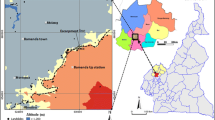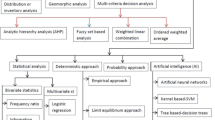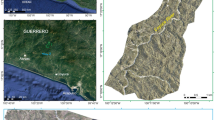Abstract
India is now housing 17% of the world’s population. Landslides are an increasing concern in India due to the rapid population expansion in hilly and mountainous terrain. Landslides affect vast areas within India, in particular in the Himalayan chain in the North and Eastern part of the country and the Western Ghats in the Southwest. The Geological Survey of India (GSI) has been designated as agency responsible for landslide inventory, susceptibility and hazard assessment. Until recently their landslide susceptibility assessment was based on a heuristic approach using fixed weights or ranking of geofactors, following guidelines of the Bureau of Indian Standards (BIS). However, this method is disputed as it doesn’t provide accurate results.
This paper gives an overview of recent research on how the existing methods for landslide inventory, susceptibility and hazard assessment in India could be improved, and how these could be used in (semi)quantitative risk assessment. Due to the unavailability of airphotos in large parts of India, satellite remote sensing data has become the standard data input for landslide inventory mapping. The National Remote Sensing Center (NRSC) has developed an approach using semi-automatic image analysis algorithms that combine spectral, shape, texture, morphometric and contextual information derived from high resolution satellite data and DTMs for the preparation of new as well as historical landslide inventories. Also the use of existing information in the form of maintenance records, and other information to generate event-based landslide inventories is presented. Event-based landslide inventories are used to estimate the temporal probability, landslide density and landslide size distribution.
Landslide susceptibility methods can be subdivided in heuristic, statistical and deterministic methods. Examples are given on the use of these methods for different scales of analysis. For medium scales a method is presented to analyze the spatial association between landslides and causal factors, including those related to structural geology, to select the most appropriate spatial factors for different landslide types, and integrate them using a combination of heuristic and multivariate methods. For transportation corridors a method is presented for quantitative hazard and risk assessment based on a nearly complete landslide database. Deterministic methods using several dynamic slope-hydrology and slope stability models have been applied to evaluate the relation between landuse changes and slope stability.
The susceptibility maps can be combined with the landslide databases to convert them into hazard maps which are subsequently used in (semi) quantitative risk assessment at different scales of analysis.
Access this chapter
Tax calculation will be finalised at checkout
Purchases are for personal use only
Similar content being viewed by others
References
Anbalagan R (1992) Landslide hazard evaluation and zonation mapping in mountainous terrain. Eng Geol 32(4):269–277
Begueria S, van Asch TWJ, Malet JP, Grondahl S (2009) A GIS-based numerical model for simulating the kinematics of mud and debris flows over complex terrain. Nat Hazards Earth Syst Sci 9(6):1897–1909
Bhandari RK (2006) The Indian landslide scenario, strategic issues and action points, a key note address – technical session on landslides. First India disaster management congress, New Delhi, 29–30 Nov 2006
BIS (1998) Preparation of landslide hazard zonation maps in mountainous terrains, IS 14496 (Part - 2) – Guidelines, Bureau of Indian Standards, Government of India, New Delhi
BMTPC (2003) Landslide hazard zonation atlas of India. Published by Building Materials and technology Promotion Council, Government of India and Anna University, Chennai
Das IC, Sahoo S, Van Westen CJ, Stein A, Hack R (2010) Landslide susceptibility assessment using logistic regression and its comparison with a rock mass classification system, along a road section in the northern Himalayas (India). Geomorphology 114(4):627–637
Das I, Stein A (Promotor), Kerle N (assistant promotor) (2011) Spatial statistical modelling for assessing landslide hazard and vulnerability. Ph.D thesis, University of Twente; summaries in Dutch and English. ITC Dissertation 192, ISBN: 978-90-6164-312-8
Ghosh S, van Westen CJ, Carranza EJM, Ghoshal T, Sarkar N, Surendranath M (2009a) A quantitative approach for improving the BIS (Indian) method of medium-scale landslide susceptibility. J Geol Soc India 74:625–638
Ghosh S, van Westen CJ, Carranza EJM, Jetten VG (2009b) Generation of event – based landslide inventory maps in a data – scarce environment: case study around Kurseong, Darjeeling district, West Bengal, India. In: Malet JP, Remaitre A, Bogaard T (eds) Landslide processes: from geomorphologic mapping to dynamic modeling: proceedings of the landslide processes, European Centre on Geomorphological Hazards (CERG), Strasbourg, pp 37–44
Ghosh S, Carranza EJM (2010) Spatial analysis of mutual fault/fracture and slope controls on rocksliding in Darjeeling Himalaya, India. Geomorphology 122:1–24
Ghosh S, Günther A, Carranza EJM, van Westen CJ, Jetten VG (2010) Rock slope instability assessment using spatially distributed structural orientation data in Darjeeling Himalaya (India). Earth Surf Proc Landf 35:1773–1792
Ghosh S, Carranza EJM, van Westen CJ, Jetten VG, Bhattacharya DN (2011a) Selecting and weighting of spatial predictors for empirical modeling of landslide susceptibility in Darjeeling Himalaya (India). Geomorphology 131(1–2):35–56
Ghosh S, Jetten VG (Promotor), van Westen CJ (assistant promotor), Carranza EJM (assistant promotor) (2011b) Knowledge guided empirical prediction of landslide hazard (e-book). University of Twente Faculty of Geo-Information and Earth Observation ITC, Enschede. ITC Dissertation 190, ISBN: 978-90-6164-310-4
Ghosh S, van Westen CJ, Carranza EJM, Jetten VG (2012a) Integrating spatial, temporal and magnitude probability for medium scale landslide hazard and risk analysis in Darjeeling Himalayas (India). Landslides: J Int Consortium Landslides, 9(3):371–384
Ghosh S, van Westen CJ, Carranza EJM, Jetten VG, Cardinali M, Rossi M, Guzzetti F, (2012b) Generating event-based landslide maps in a data-scarce Himalayan environment for estimating temporal and magnitude probability. Eng Geol 128:49–62
Günther A (2003) SLOPEMAP: programs for automated mapping of geometrical and kinematical properties of hard rock hill slopes. Comput Geosci 29:865–875
Jaiswal P, van Westen CJ (2009) Estimating temporal probability for landslide initiation along transportation routes based on rainfall threshold. Geomorphology 112:96–105
Jaiswal P, van Westen CJ, Jetten V (2010a) Quantitative landslide hazard assessment along a transportation corridor in southern India. Eng Geol 116:236–250
Jaiswal P, van Westen CJ, Jetten V (2010b) Quantitative assessment of direct and indirect landslide risk along transportation lines in southern India. Nat Hazards Earth Syst Sci 10:1253–1267
Jaiswal P, van Westen CJ, Jetten VG (2011a) Quantitative assessment of landslide hazard along transportation lines using historical records. In: Landslides: J Int Consortium Landslides 8(3):279–291
Jaiswal P, van Westen CJ, Jetten V (2011b) Quantitative assessment of landslide hazard along transportation lines using historical records. Landslides. doi:10.1007/s10346-011-0252-1
Jaiswal P, Jetten VG (Promotor), van Westen CJ (assistant promotor), Ayyasami K (assistant promotor) (2011c) Landslide risk quantification along transportation corridors based on historical information (e-book). University of Twente Faculty of Geo-Information and Earth Observation ITC, Enschede. ITC Dissertation 191, ISBN: 978-90-6164-311-1
Kuriakose SL, Jetten VG, van Westen CJ, Sankar G, van Beek LPH (2008) Pore water pressure as a trigger of shallow landslides in the western Ghats of Kerala, India: some preliminary observations from an experimental catchment. Phys Geogr 29(4):374–386
Kuriakose SL, van Beek LPH, van Westen CJ (2009a) Parameterizing a physically based shallow landslide model in a data poor region. Earth surf proc landf 34(6):867–881
Kuriakose SL, Sanjaya Devkota DG, Rossiter VGJ (2009b) Prediction of soil depth using environmental variables in an anthropogenic landscape, a case study in the Western Ghats of Kerala, India. Catena 79(1):27–38
Kuriakose SL, Jetten VG (Promotor), de Jong SM (Promotor), van Westen CJ (co-promotor), van Beek LPH (co-promotor) (2010) Physically-based dynamic modelling of the effect of land use changes on shallow landslide initiation in the Western Ghats of Kerala, India + CD-ROM with appendices. University of Twente Faculty of Geo-Information and Earth Observation ITC, Enschede. ITC Dissertation 178, ISBN: 978-90-6164-298-5
Kuriakose SL, van Beek LPH (2011) Plant root strength and slope stability. In: Glinski J, Horabik J, Lipiec J (eds) Encyclopaedia of agrophysics, Encyclopaedia of earth sciences series. Springer, Dordrecht. doi:10.1007/978-90-481-3585-1
Martha TR, Kerle N, van Westen CJ, Jetten V, Vinod Kumar K (2010a) Effect of sun elevation angle on DSMs derived from Cartosat - 1 data. Photogramm Eng Remote Sens 76(4):429–438
Martha TR, Kerle N, van Westen CJ, Jetten V, Vinod Kumar K (2010b) Landslide volumetric analysis using Cartosat - 1 derived DEMs. IEEE Geosci Remote Sens Lett 7(3):582–586
Martha TR, Kerle N, van Westen CJ, Jetten V, Vinod Kumar K (2010c) Characterising spectral, spatial and morphometric properties of landslides for semi – automatic detection using object – oriented methods. Geomorphology 116(1–2):24–36
Martha TR, Kerle N, van Westen CJ, Jetten V, Vinod Kumar K (2011a) Segment optimisation and data-driven thresholding for knowledge-based landslide detection by object-based image analysis. IEEE Trans Geosci Remote Sens 49(12):4928–4943
Martha TR, Jetten VG (Promotor), van Westen CJ (assistant promotor), Kerle N (assistant promotor) (2011b) Detection of landslides by object – oriented image analysis (e-book). University of Twente Faculty of Geo-Information and Earth Observation ITC, Enschede. ITC Dissertation 189, ISBN: 978-90-6164-309-8
Martha TR, Kerle N, van Westen CJ, Jetten V, Vinod Kumar K (2012) Object-oriented analysis of multi-temporal panchromatic images for creation of historical landslide inventories. ISPRS J Photogramm Remote Sens 67:105–119
Martha TR, Kerle N, van Westen CJ, Jetten V, Vinod Kumar K (2013) Landslide hazard and risk assessment using landslide inventories created semi-automatically by object-oriented analysis. Geomorphology 184(February):139–150
Nadim F, Kjekstad O (2009) Assessment of global high-risk landslide disaster hotspots. In: Sassa K, Canuti P (eds) Landslides – Diaster risk reduction. Springer, Berlin, pp 213–221
NDMA (2009) Management of landslides and snow avalanches, 2009. National Disaster Management Authority (NDMA), Government of India, New Delhi, pp 144pp
OFDA/CRED (2010) EM-DAT International Disaster Database. www.em-dat.net. Université Catholique de Louvain, Brussels, Belgium
Petley DN, Dunning SA, Rosser NJ (2005) The analysis of global landslide risk through the creation of a database of worldwide landslide fatalities. In: Hungr O, Fell R, Couture R, Eberhardt E (eds) Landslide risk management. Taylor & Francis, London, pp 367–373
Rajarathnam S, Ganapathy GP (2006) Landslide hazard zonation of India using GIS techniques. Thematic session – landslide, avalanche and other mass movements. First Indian disaster management congress, New Delhi, India, 29–30 Nov 2006
Sarkar S, Kanungo DP (2005) Landslide hazard zonation in India: a review. In: Proceedings of the international conference on geotechnical engineering for disaster management & rehabilitation, Kyoto University, Japan
Sharda YP (2008) Landslide studies in India, glimpses of geoscience research in India. The Indian report to IUGS 20042008, Indian National Science Academy, Silver Jubilee Volume, pp 98–101
van Westen CJ, Castellanos E, Kuriakose SL (2008) Spatial data for landslide susceptibility, hazard, and vulnerability assessment: an overview. Eng Geol 102:112–131
Acknowledgments
This research was carried out under the collaboration agreement between the Geological Survey of India (GSI), the National Remote Sensing Center (Indian Space Research Organisation) and the United Nations University – ITC School for Disaster Geo-Information Management, University of Twente, the Netherlands.
We acknowledge the contribution of the following researchers, who collaborated in some way to the project (e.g. through joint field campaigns, training courses, image interpretation, modelling and discussions): Mauro Cardinali, Paola Reichenbach, Mauro Rossi and Fausto Guzzetti (CNR-IRPI); Andreas Günther (BGR); John Carranza, Norman Kerle, Victor Jetten and Alfred Stein (ITC); Steven de Jong, Theo van Asch and Rens van Beek (Utrecht University); Santiago Begueria (University of Zaragoza, Spain); Thomas Glade (University of Vienna); Jean-Philippe Malet (CNRS, Strasbourg); Dr. Sankar (CESS); P.K. Champati Ray and R.C. Lakhera (IIRS); Vinod Kumar (NRSC). The project was possible due to the efforts made by Dr. Rajendran of GSI. The research was also a contribution to the EU FP7 SafeLand project (www.safeland-fp7.eu) in which India is one of the two countries selected outside of Europe.
Author information
Authors and Affiliations
Corresponding author
Editor information
Editors and Affiliations
Rights and permissions
Copyright information
© 2013 Springer-Verlag Berlin Heidelberg
About this chapter
Cite this chapter
van Westen, C.J., Ghosh, S., Jaiswal, P., Martha, T.R., Kuriakose, S.L. (2013). From Landslide Inventories to Landslide Risk Assessment; An Attempt to Support Methodological Development in India. In: Margottini, C., Canuti, P., Sassa, K. (eds) Landslide Science and Practice. Springer, Berlin, Heidelberg. https://doi.org/10.1007/978-3-642-31325-7_1
Download citation
DOI: https://doi.org/10.1007/978-3-642-31325-7_1
Published:
Publisher Name: Springer, Berlin, Heidelberg
Print ISBN: 978-3-642-31324-0
Online ISBN: 978-3-642-31325-7
eBook Packages: Earth and Environmental ScienceEarth and Environmental Science (R0)




